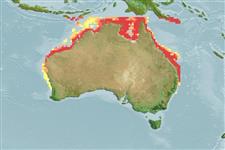Common names from other countries
Environment: milieu / climate zone / depth range / distribution range
Écologie
; profondeur 8 - 61 m (Ref. 105423). Subtropical; 10°S - 33°S, 112°E - 154°E
Distribution
Pays | Zones FAO | Écosystèmes | Occurrences | Introductions
Indo-Pacific: Endemic to Australia.
Length at first maturity / Taille / Poids / Âge
Maturity: Lm 2.2 range ? - ? cm Max length : 14.5 cm TL mâle / non sexé; (Ref. 8); 15.5 cm TL (female)
Found on seagrass and offshore habitats (Ref. 104903). Postlarvae settle exclusively in seagrass beds (Ref. 84594). Juveniles live almost exclusively in shallow seagrass beds (Ref. 105190). They feed on bivalves, gastropods, ophiuroids, crustaceans and polychaetes (Ref. 104903), diatoms, filamentous algae, and seagrass (Ref. 105190).
Life cycle and mating behavior
Maturité | Reproduction | Frai | Œufs | Fécondité | Larves
Members of the order Decapoda are mostly gonochoric. Mating behavior: Precopulatory courtship ritual is common (through olfactory and tactile cues); usually indirect sperm transfer.
Holthuis, L.B. 1980. (Ref. 8)
Statut dans la liste rouge de l'IUCN (Ref. 130435)
statut CITES (Ref. 108899)
Not Evaluated
Not Evaluated
Utilisations par l'homme
Pêcheries: commercial
FAO - Aquaculture: production; | FishSource | Sea Around Us
Outils
Sources Internet
Estimates based on models
Preferred temperature
(Ref.
115969): 24.6 - 28.2, mean 26.7 (based on 184 cells).
Résilience
Haut, temps minimum de doublement de population inférieur à 15 mois (K=2.16-4.21).
Vulnérabilité
Low vulnerability (10 of 100).
